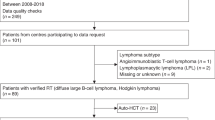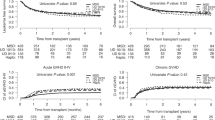Abstract
We investigated the impact of donor type on post-relapse survival (PRS) in 85 patients with hematological relapse after their first allogeneic hematological stem cell transplantation (allo-HSCT) for hematological malignancy. The median follow-up was 64 months among survivors. Both 3-year overall survival and 3-year PRS were similar in haploidentical donor (HID) and matched sibling donor (MRD) transplantation (13.0%±4.7% vs 19.4%±7.1%, P=0.913 and 7.7±3.9% vs 9.7±5.3%, P= 0.667). Higher rates of post-relapse grade II–IV and III–IV acute GvHD (aGvHD) were observed in HID transplantation patients. A higher cumulative incidence of post-relapse extensive chronic GvHD was also observed for HID transplantation patients. Multivariate analyses confirmed that treatment including donor lymphocyte infusion (DLI), late relapse >1 year, and in first CR at transplantation were associated with superior PRS (P=0.012, hazard ratio (HR)=0.527 (0.320−0.866)); P=0.033, HR=0.534 (0.300−0.952) and P=0.046, HR=0.630 (0.400−0.992). The data suggest that post-relapse outcomes are comparable in HID and MRD transplantation, and that DLI is safe for relapsed patients after haploidentical transplantation.
This is a preview of subscription content, access via your institution
Access options
Subscribe to this journal
Receive 12 print issues and online access
$259.00 per year
only $21.58 per issue
Buy this article
- Purchase on Springer Link
- Instant access to full article PDF
Prices may be subject to local taxes which are calculated during checkout

Similar content being viewed by others
References
Mohty M, Labopin M, Volin L, Gratwohl A, Socie G, Esteve J et al. Reduced-intensity vs conventional myeloablative conditioning allogeneic stem cell transplantation for patients with acute lymphoblastic leukemia: a retrospective study from the European Group for Blood and Marrow Transplantation. Blood 2010; 116: 4439–4443.
Klingebiel T, Cornish J, Labopin M, Locatelli F, Darbyshire P, Handgretinger R et al. Results and factors influencing outcome after fully haploidentical hematopoietic stem cell transplantation in children with very high-risk acute lymphoblastic leukemia: impact of center size: an analysis on behalf of the Acute Leukemia and Pediatric Disease Working Parties of the European Blood and Marrow Transplant group. Blood 2010; 115: 3437–3446.
Barrett AJ, Battiwalla M . Relapse after allogeneic stem cell transplantation. Expert Rev Hematol 2010; 3: 429–441.
Matsumoto K, Yamamoto W, Ogusa E, Ishigatsubo Y, Kanamori H . Prognostic index for relapsed acute leukemia after allogeneic stem cell transplant. Leukemia Lymphoma 2014; 55: 2808–2812.
Wang Y, Liu QF, Xu LP, Liu KY, Zhang XH, Ma X et al. Haploidentical vs identical-sibling transplant for AML in remission: a multicenter, prospective study. Blood 2015; 125: 3956–3962.
Raiola AM, Dominietto A, di Grazia C, Lamparelli T, Gualandi F, Ibatici A et al. Unmanipulated haploidentical transplants compared with other alternative donors and matched sibling grafts. Biol Blood Marrow Transplant 2014; 20: 1573–1579.
Robinson TM, O'Donnell PV, Fuchs EJ, Luznik L . Haploidentical bone marrow and stem cell transplantation: experience with post-transplantation cyclophosphamide. Semin Hematol 2016; 53: 90–97.
Bashey A, Zhang X, Sizemore CA, Manion K, Brown S, Holland HK et al. T-cell-replete HLA-haploidentical hematopoietic transplantation for hematologic malignancies using post-transplantation cyclophosphamide results in outcomes equivalent to those of contemporaneous HLA-matched related and unrelated donor transplantation. J Clin Oncol 2013; 31: 1310–1316.
Wang Y, Liu DH, Liu KY, Xu LP, Zhang XH, Han W et al. Long-term follow-up of haploidentical hematopoietic stem cell transplantation without in vitro T cell depletion for the treatment of leukemia: nine years of experience at a single center. Cancer 2013; 119: 978–985.
Passweg JR, Baldomero H, Bader P, Bonini C, Cesaro S, Dreger P et al. Hematopoietic SCT in Europe 2013: recent trends in the use of alternative donors showing more haploidentical donors but fewer cord blood transplants. Bone Marrow Transplant 2015; 50: 476–482.
Kobayashi S, Kikuta A, Ito M, Sano H, Mochizuki K, Akaihata M et al. Loss of mismatched HLA in myeloid/NK cell precursor acute leukemia relapse after T cell-replete haploidentical hematopoietic stem cell transplantation. Pediatric Blood Cancer 2014; 61: 1880–1882.
Vago L, Perna SK, Zanussi M, Mazzi B, Barlassina C, Stanghellini MT et al. Loss of mismatched HLA in leukemia after stem-cell transplantation. New Engl J Med 2009; 361: 478–488.
Wang Y, Liu DH, Xu LP, Liu KY, Chen H, Chen YH et al. Superior graft-versus-leukemia effect associated with transplantation of haploidentical compared with HLA-identical sibling donor grafts for high-risk acute leukemia: an historic comparison. Biol Blood Marrow Transplant 2011; 17: 821–830.
Yan CH, Liu DH, Liu KY, Xu LP, Liu YR, Chen H et al. Risk stratification-directed donor lymphocyte infusion could reduce relapse of standard-risk acute leukemia patients after allogeneic hematopoietic stem cell transplantation. Blood 2012; 119: 3256–3262.
Yan CH, Wang JZ, Liu DH, Xu LP, Chen H, Liu KY et al. Chemotherapy followed by modified donor lymphocyte infusion as a treatment for relapsed acute leukemia after haploidentical hematopoietic stem cell transplantation without in vitro T-cell depletion: superior outcomes compared with chemotherapy alone and an analysis of prognostic factors. Eur J Haematol 2013; 91: 304–314.
Przepiorka D, Weisdorf D, Martin P, Klingemann HG, Beatty P, Hows J et al. 1994 Consensus Conference on Acute GvHD Grading. Bone Marrow Transplant 1995; 15: 825–828.
Sullivan KM, Shulman HM, Storb R, Weiden PL, Witherspoon RP, McDonald GB et al. Chronic graft-versus-host disease in 52 patients: adverse natural course and successful treatment with combination immunosuppression. Blood 1981; 57: 267–276.
Efron B . Logistic regression. Surv Anal Kaplan-Meier Curve 1988; 83: 425.
Scrucca L, Santucci A, Aversa F . Regression modeling of competing risk using R: an in depth guide for clinicians. Bone Marrow Transplant 2010; 45: 1388–1395.
Arellano ML, Langston A, Winton E, Flowers CR, Waller EK . Treatment of relapsed acute leukemia after allogeneic transplantation: a single center experience. Biol Blood Marrow Transplant 2007; 13: 116–123.
Takami A, Yano S, Yokoyama H, Kuwatsuka Y, Yamaguchi T, Kanda Y et al. Donor lymphocyte infusion for the treatment of relapsed acute myeloid leukemia after allogeneic hematopoietic stem cell transplantation: a retrospective analysis by the Adult Acute Myeloid Leukemia Working Group of the Japan Society for Hematopoietic Cell Transplantation. Biol Blood Marrow Transplant 2014; 20: 1785–1790.
Spyridonidis A, Labopin M, Schmid C, Volin L, Yakoub-Agha I, Stadler M et al. Outcomes and prognostic factors of adults with acute lymphoblastic leukemia who relapse after allogeneic hematopoietic cell transplantation. An analysis on behalf of the Acute Leukemia Working Party of EBMT. Leukemia 2012; 26: 1211–1217.
Solh M, Zhang X, Connor K, Brown S, Solomon SR, Morris LE et al. Post-relapse survival after haploidentical transplantation vs matched-related or matched-unrelated hematopoietic cell transplantation. Bone Marrow Transplant 2016; 51: 949–954.
Chang YJ, Huang XJ . Donor lymphocyte infusions for relapse after allogeneic transplantation: when, if and for whom? Blood Rev 2013; 27: 55–62.
Yan C, Xu L, Liu D, Chen H, Wang Y, Liu K et al. Immunosuppression for 6–8 weeks after modified donor lymphocyte infusion reduced acute graft-versus-host disease without influencing graft-versus-leukemia effect in haploidentical transplant. Chin Med J 2014; 127: 3602–3609.
Kurosawa S, Fukuda T, Tajima K, Saito B, Fuji S, Yokoyama H et al. Outcome of 93 patients with relapse or progression following allogeneic hematopoietic cell transplantation. Am J Hematol 2009; 84: 815–820.
Duncan CN, Majhail NS, Brazauskas R, Wang Z, Cahn JY, Frangoul HA et al. Long-term survival and late effects among one-year survivors of second allogeneic hematopoietic cell transplantation for relapsed acute leukemia and myelodysplastic syndromes. Biol Blood Marrow Transplant 2015; 21: 151–158.
Byrne M, Savani BN . The devil is in the T cells: relapsing after haploidentical hematopoietic cell transplantation. Bone Marrow Transplant 2016; 51: 915–918.
Topp MS, Gokbuget N, Zugmaier G, Klappers P, Stelljes M, Neumann S et al. Phase II trial of the anti-CD19 bispecific T cell-engager blinatumomab shows hematologic and molecular remissions in patients with relapsed or refractory B-precursor acute lymphoblastic leukemia. J Clin Oncol 2014; 32: 4134–4140.
Maude SL, Teachey DT, Porter DL, Grupp SA . CD19-targeted chimeric antigen receptor T-cell therapy for acute lymphoblastic leukemia. Blood 2015; 125: 4017–4023.
Stone RM, Mandrekar S, Sanford BL, Geyer S, Bloomfield CD, Dohner K et al. The multi-kinase inhibitor midostaurin (M) prolongs survival compared with placebo (P) in combination with daunorubicin (D)/cytarabine (C) induction (ind), high-dose C consolidation (consol), and as maintenance (maint) therapy in newly diagnosed acute my. Blood 2015; 126: 6–6.
Eapen M, Giralt SA, Horowitz MM, Klein JP, Wagner JE, Zhang MJ et al. Second transplant for acute and chronic leukemia relapsing after first HLA-identical sibling transplant. Bone Marrow Transplant 2004; 34: 721–727.
Bolanos-Meade J, Smith BD, Gore SD, McDevitt MA, Luznik L, Fuchs EJ et al. 5-azacytidine as salvage treatment in relapsed myeloid tumors after allogeneic bone marrow transplantation. Biol Blood Marrow Transplant 2011; 17: 754–758.
Schroeder T, Czibere A, Platzbecker U, Bug G, Uharek L, Luft T et al. Azacitidine and donor lymphocyte infusions as first salvage therapy for relapse of AML or MDS after allogeneic stem cell transplantation. Leukemia 2013; 27: 1229–1235.
Maude SL, Frey N, Shaw PA, Aplenc R, Barrett DM, Bunin NJ et al. Chimeric antigen receptor T cells for sustained remissions in leukemia. New Engl J Med 2014; 371: 1507–1517.
Acknowledgements
This work was partly supported by grants from the Collaborative Innovation Center of Hematology in China, the Key Program of the National Natural Science Foundation of China (numbers 81230013 and 81530046). We thank the faculty members who participated in these studies.
Author information
Authors and Affiliations
Corresponding author
Ethics declarations
Competing interests
The authors declare no conflict of interest.
Rights and permissions
About this article
Cite this article
Ma, YR., Xu, LP., Zhang, XH. et al. Comparable post-relapse outcomes between haploidentical and matched related donor allogeneic stem cell transplantation. Bone Marrow Transplant 52, 409–414 (2017). https://doi.org/10.1038/bmt.2016.283
Received:
Revised:
Accepted:
Published:
Issue Date:
DOI: https://doi.org/10.1038/bmt.2016.283
This article is cited by
-
Prognosis and risk factors for central nervous system relapse after allogeneic hematopoietic stem cell transplantation in acute myeloid leukemia
Annals of Hematology (2021)
-
Comparison of central nervous system relapse outcomes following haploidentical vs identical-sibling transplant for acute lymphoblastic leukemia
Annals of Hematology (2020)
-
The benefit of chronic graft-versus-host disease in patients with acute myeloid leukemia relapsed after allogeneic stem cell transplantation
Annals of Hematology (2019)



